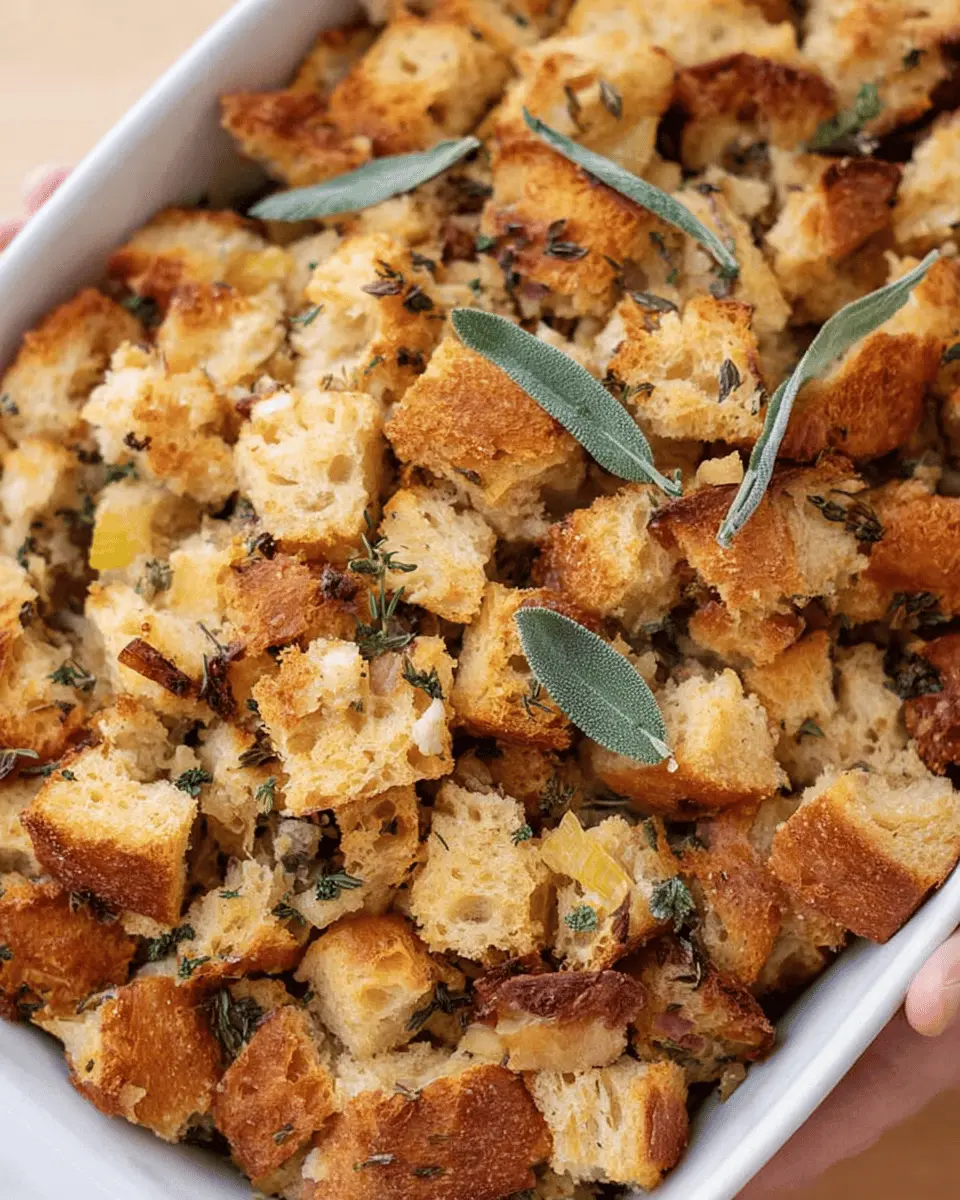Introduction to Sourdough Stuffing
Sourdough stuffing is a delightful twist on traditional stuffing that brings layers of flavor and texture to your meals. Using homemade sourdough bread, this recipe infuses a unique tanginess that elevates the dish. Whether it’s for Thanksgiving, a festive dinner, or just a cozy gathering, this hearty side shines alongside your main course.
Why Choose Sourdough Stuffing for Your Meals?
There are plenty of reasons to opt for a sourdough stuffing recipe over classic options. First, the chewy texture and crusty edges of sourdough bread add a wonderful crunch—you won’t find that with standard bread. Plus, sourdough is typically easier to digest, thanks to the fermentation process that breaks down gluten and enhances nutrient absorption. Did you know that sourdough dough fermentation can improve the bioavailability of minerals in the bread, making it a healthier choice?
Moreover, sourdough stuffing can be easily customized with your favorite additions, from fresh herbs like thyme and sage to proteins such as turkey bacon or chicken ham. The versatility of this stuffing fits seamlessly into a variety of meal themes, making it a crowd-pleaser for any occasion.
So, why not try this mouthwatering, simple-to-make dish that will surely impress your guests? Explore the full recipe below!

Ingredients for Sourdough Stuffing
Essential ingredients for a perfect sourdough stuffing
Creating a mouthwatering sourdough stuffing recipe starts with the essentials. Here’s what you need:
- Sourdough Bread: About 1 pound, preferably homemade for that fresh flavor.
- Butter: One stick of salted butter gives richness and depth to your stuffing.
- Vegetables: Chopped celery and onion add a wonderful base.
- Herbs: Fresh sage and thyme are delightful, but dried herbs will work too.
- Broth: Homemade chicken broth (3 cups) is ideal, but ensure it's unsalted for better control over seasoning.
- Eggs: Two large eggs help bind everything together.
- Salt and Pepper: To taste, but be cautious with salt if your broth is already salted.
Optional ingredients to customize your stuffing
Feel free to get a bit adventurous with your stuffing! Some delicious optional additions are:
- Nuts: Chopped walnuts or pecans add a delightful crunch.
- Fruits: Diced apples or dried cranberries can introduce a touch of sweetness.
- Protein: Consider adding sautéed turkey bacon or chicken ham for extra flavor.
- Veggies: Carrots, mushrooms, or garlic can elevate your stuffing further.
Have fun trying out your own combinations! You might just discover your new favorite family recipe. For more inspiration, you can check out resources on seasonal ingredients or cooking techniques here or here.
Preparing Sourdough Stuffing
Making delicious sourdough stuffing is a perfect way to elevate your holiday meals or cozy family dinners. The rich, tangy flavor of sourdough paired with sautéed veggies creates a delightful side dish that’s sure to impress. Let’s dive into how to bring this scrumptious dish to life with our sourdough stuffing recipe.
Prepare Your Sourdough Bread
Start by prepping your sourdough bread. If you’re making it from scratch, let it cool completely before cutting. This is crucial because stale bread holds up better in stuffing and allows the flavors to meld beautifully. Aim for a small round loaf, weighing around a pound—this amount should yield about eight servings. You can use leftover sourdough if you have it on hand; just make sure it’s not too fresh!
Toasting the Bread Cubes
Once your bread is ready, cut it into 1-inch cubes. Toasting these cubes in butter is essential for adding that delightful texture. Preheat your oven to 350°F (175°C) and place half a stick of salted butter in your baking dish or cast iron skillet as it warms. When the butter’s melted, add in your bread cubes, tossing them to coat evenly. Bake for about 20 minutes, stirring halfway through. You want a lovely golden color that'll add crunch in every bite!
Sautéing Vegetables for Flavor
While your bread is toasting, it’s time to sauté the vegetables. In a skillet, melt the remaining butter over medium heat, then add chopped celery and onions. Cook them until soft, which usually takes around 5-10 minutes. Season with salt and pepper. The aromatic blend of veggies will add a depth of flavor that perfectly complements the satisfying crunch of your toasted sourdough.
Mixing the Broth and Egg Mixture
In a large bowl, whisk together the homemade chicken broth and eggs. This eggy broth will bind your stuffing while enhancing its richness. Be sure to choose a broth that you love, as it greatly impacts the flavor profile. Your sourdough stuffing recipe can shine with fresh herbs too—sage and thyme are fantastic choices.
Combining Everything in the Baking Dish
Pull out those beautifully toasted bread cubes and pour your broth and vegetable mixture over them. Give everything a gentle mix, ensuring the bread absorbs as much liquid as possible. It’s important to let this sit for about 10 minutes so the flavors can meld.
Baking to Golden Perfection
Finally, it’s time for the last step—baking! Spread the mixture evenly in your baking dish and pop it back in the oven. Bake for 25-30 minutes, or until you get that beautiful golden-brown color on top. The enticing aroma wafting from your oven will make your mouth water in anticipation!
With these steps, your sourdough stuffing is not just a side dish; it’s a highlight of your meal. Enjoy every delectable bite! For more insight into the benefits of using high-quality ingredients, you can check out resources like Organic Consumers Association or The Kitchn for expert insights.

Variations of Sourdough Stuffing
When it comes to sourdough stuffing, there are endless possibilities to explore. Whether you’re aiming for a hearty dish or something more veggie-centric, try these delicious variations!
Sourdough Sausage Stuffing with Turkey Bacon
If you're craving a protein-packed option, consider adding turkey bacon to your sourdough stuffing recipe. Simply fry the turkey bacon until crispy and crumble it into the mix along with some sautéed onions and celery. The smoky flavor of the bacon pairs wonderfully with the aromatic herbs, creating a rich and savory stuffing your guests will love. Plus, it’s a delightful twist that can impress even the most discriminating palates.
Veggie-Packed Sourdough Stuffing
For those looking to incorporate more vegetables, a veggie-packed sourdough stuffing can be a game changer. Enhance the recipe by adding mushrooms, bell peppers, and even nuts for crunch. The diversity of flavors not only boosts nutrition but also creates a colorful and textured dish. Plus, it’s a fantastic way to use up leftover veggies from your fridge. Think of it as a canvas where you can blend in any seasonal vegetables you have on hand.
Both variations provide a fresh take on a classic dish, ensuring that your sourdough stuffing stands out this holiday season! For more ideas and inspiration, check out sources like Food Network or Bon Appétit.
Cooking Tips and Notes for Sourdough Stuffing
Making it Ahead of Time
You can make this sourdough stuffing recipe a day in advance! Simply prepare it up to the baking stage, then cover it tightly and keep it in the fridge. On Thanksgiving Day, just pop it in the oven while your turkey rests.
Tips for Gluten-Free Variations
If you're looking to accommodate gluten-free eaters, substitute the sourdough bread for a gluten-free bread of your choice. Just ensure you have enough moisture since gluten-free bread can dry out more easily.
Using Dried Herbs Instead of Fresh
Fresh herbs can elevate your dish, but dried herbs work beautifully too! Remember, one teaspoon of dried herbs is equivalent to one tablespoon of fresh. When using dried herbs, add them to the sautéed vegetables to help release their flavors. For more cooking tips, check out resources from the USDA or culinary experts on food preservation from The Spruce Eats.

Serving Suggestions for Sourdough Stuffing
Ideal Pairings for Holiday Meals
Your sourdough stuffing recipe will shine brightly next to all your favorite holiday dishes! Consider serving it alongside classic roasted turkey, glazed chicken ham, or savory herb-crusted beef. For a lighter option, pair it with a fresh, zesty salad topped with vinaigrette. The buttery flavors of the stuffing balance nicely with citrusy options like a cranberry or orange salad. Want a quick drink? A homemade apple cider or spiced tea is the perfect complement to warm, rich stuffing.
Creative Ways to Repurpose Leftover Stuffing
Don’t let any stuffing go to waste! Transform leftovers into delicious breakfast dishes. Sauté the stuffing with turkey bacon or eggs for a hearty breakfast scramble. Alternatively, use it as a filling for stuffed bell peppers or a topping for casseroles. You can also mix it with pasta and a light sauce for a unique twist on a classic dish. The options are endless—just let your imagination run wild!
Time Breakdown for Sourdough Stuffing
Preparation Time
Getting everything ready will take about 10 minutes. This includes chopping vegetables, cubing your sourdough bread, and gathering the ingredients you’ll need.
Cooking Time
The cooking process will take approximately 40 minutes. This includes toasting the bread, sautéing the veggies, and baking the stuffing to golden perfection.
Total Time
From start to finish, your delicious sourdough stuffing recipe will be ready in just 50 minutes! Perfect for fitting into your busy holiday schedule.
Feeling inspired? For more tips on how to create the best stuffing, check out Serious Eats for insights from culinary experts!
Nutritional Facts for Sourdough Stuffing
Calories
A serving of this delicious sourdough stuffing recipe packs about 289 calories. This makes it a relatively moderate option for side dishes, allowing you to indulge without overdoing it.
Protein
With 9 grams of protein, this stuffing not only complements your turkey and gravy but also contributes to your daily intake. Pairing it with a protein-rich main can help make your holiday meal well-rounded.
Sodium
Be mindful of sodium levels! Each serving contains approximately 2534 mg of sodium. If you're watching your salt intake, consider using unsalted broth or reducing the added salt to keep your heart happy.
By incorporating these nutritional aspects into your dining experience, you can enjoy the flavors of sourdough stuffing while being mindful of your health. For more detailed nutrition insights, consult the USDA FoodData Central.
FAQ about Sourdough Stuffing
Can I use stale sourdough bread?
Absolutely! In fact, stale sourdough bread is perfect for our sourdough stuffing recipe. It helps absorb the broth and keeps the stuffing from becoming too mushy. Just make sure to cube the bread and toast it lightly. This will revive the flavors and add a delightful crunch!
How do I store leftovers?
To store your delicious leftover sourdough stuffing, transfer it to an airtight container and refrigerate. It should last for about 3-4 days. When you're ready to enjoy it again, simply reheat in the oven at 350°F until warmed through. For extra crispiness, you can broil it for a minute or two!
What can I substitute for chicken broth?
If you're looking for alternatives to chicken broth, consider using vegetable broth or even mushroom broth for a rich umami flavor. You could also enhance sodium levels by utilizing homemade bone broth for a nutritional boost. For those avoiding animal products altogether, a quality vegetable-based broth works wonders in a sourdough stuffing recipe!
Conclusion on Sourdough Stuffing
In summary, this sourdough stuffing recipe brings warmth and flavor to your dining table. With its delightful texture and rich ingredients, it’s a dish that can be personalized to suit your taste. Whether you serve it for holidays or a comforting family dinner, it’s sure to impress!
For more inspiration, check out this guide to seasonal side dishes or dive into our favorite bread recipes. Enjoy your cooking adventure!

Sourdough Stuffing Recipe
Equipment
- baking dish
- skillet
- Mixing bowl
Ingredients
Bread
- 1 pound small round sourdough bread
Butter
- 1 stick salted butter
Vegetables
- 3 stalks celery chopped
- 1 medium onion chopped
Herbs
- 1 tablespoon chopped fresh sage or 1 teaspoon dried
- 1 tablespoon chopped fresh thyme or 1 teaspoon dried
Broth and Eggs
- 3 cups homemade chicken broth (unsalted)
- 2 large eggs
Seasoning
- 2 tablespoons salt (reduce if using salted broth)
- ½ tablespoon pepper
Instructions
Preparation
- Prepare and bake homemade sourdough bread, if making from scratch.
- Preheat the oven to 350 F.
- Add half of the butter to a baking dish (or cast iron skillet) and place in the oven to melt.
- Cut the crusty sourdough bread into 1-inch cubes.
- Take out the baking dish from the oven and toss the melted butter with the bread.
- Bake for 20 minutes, stirring halfway in between so the bread cubes don’t get burnt, but rather get nice and toasty.
- Dice onions and celery.
- Sauté onions and celery over medium heat in a skillet with the remaining butter until they are a little soft, around 5-10 minutes.
- Add salt and pepper.
- Pull the toasted bread out of the oven.
- In a large bowl, add bone broth and eggs and whisk together.
- Add the vegetable mixture and herbs to the broth mixture and mix well.
- Pour the broth and vegetable mixture over the toasted bread and let it sit for 10 minutes to allow bread to soak up the eggs and broth.
- Bake for 25-30 minutes, until it starts to turn golden brown.





Leave a Reply